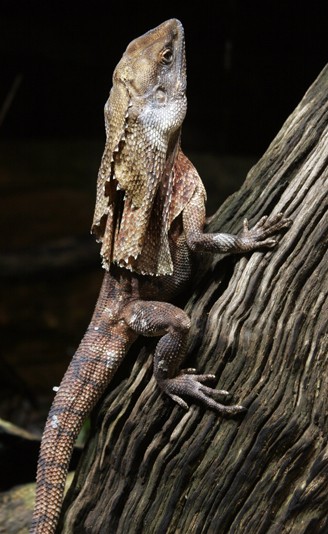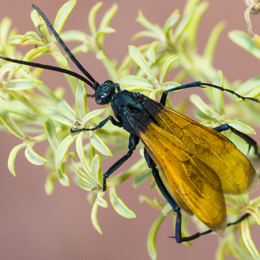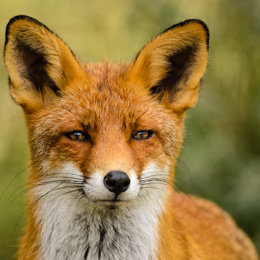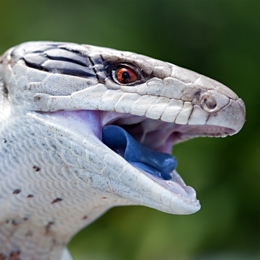Description
The frilled lizard, also known as the frilled neck lizard, frilled dragon or dragon lizard, is a unique reptile, popular for its frill around the neck. Though they are found only in the dry woodlands of Australia and New Guinea, they are quite popular around the world for their unique defence strategy.
When threatened, the lizard spreads out its reddish frill, opens its mouth wide and hisses aggressively at the threat. The unique frill around its neck consists of spines made of cartilage. The spines are connected to the jaw bone of the frill-neck. To expand the frill, it opens its jaw and erects the spines that support the flap of skin around its neck. The frill can be up to 20-25cm in diameter when expanded. It can be red, yellow or orange in colour with random black spots in them.
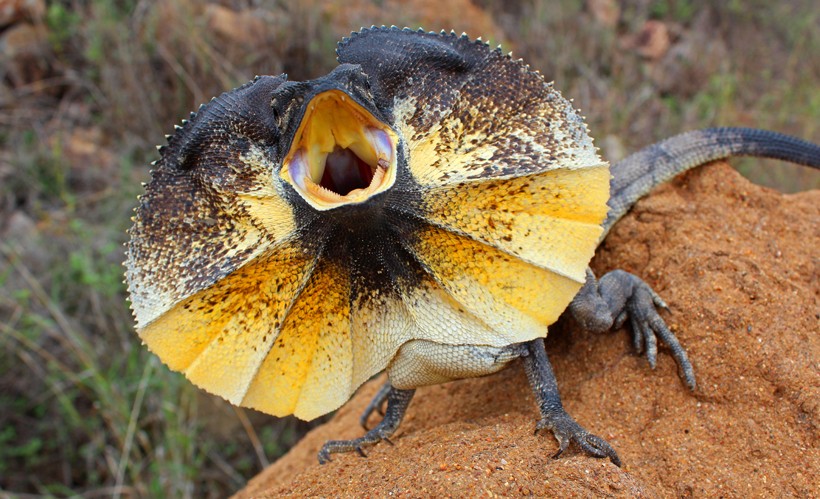
The fearless frilled lizard challenges any threat in its territory with a tremendous display of aggressive hissing and intimidating.
?
Image credits: Matt Cornish/Shutterstock
If timed correctly, the vicious aggressive display can scare even the largest land animals, but the cold-blooded frilled-neck lizard is not dangerous at all. The entire display of aggression is just a bluff, used to stun the enemy.
As soon as it sees an opportunity to escape, the frilled-neck lizard simply runs to the safety of a nearby tree. The lizard lifts up its upper body and runs swiftly on its hind legs like humans. This unique frilled lizard running style enables it to run safely on uneven grounds covered with dried leaves and twigs fallen from the surrounding trees of the woodland. The upright posture also offers a wider range of vision while running.
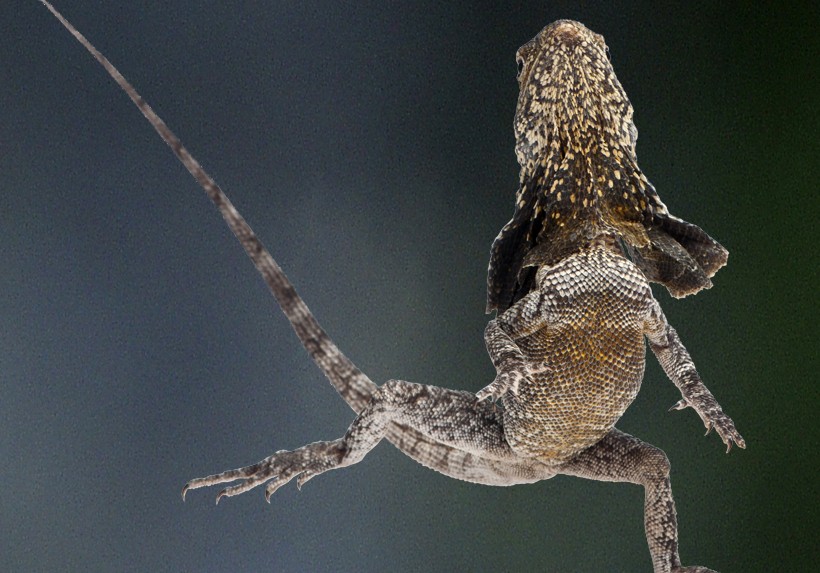
Frilled lizards run like humans on two legs
?
Image credits: Eric Isselee/Shutterstock
Frilled lizards run fast and can reach speeds of 20-25 km/h, which is a good speed for lizards. The tail plays a key role in this two-legged sprint.
The frill-neck holds its tail just above the ground level and uses it as a counterweight to maintain a low centre of gravity, obtaining more stability while running. Its strong tail can make up to 65-70 percent of its entire body length. It can grow for up to 3 feet in length from head to the tip of the tail.
Males can be easily differentiated due to their larger sizes compared to females. Male frilled lizards possess larger frills, wider heads and more powerful jaws than the females of the same species. Not much is known about its lifespan in the wild, but frilled-neck lizards in captivity have been recorded to live for up to 15-20 years.
They are large lizards with adults weighing more than half a kilogram and majorly rely on their eyes, to spot prey and predators in its territory. They have a moderate sense of smell, but can easily spot even the tiniest insects wandering on forest grounds with its strong sense of vision.
Habitat
Though they are known to run and hunt insects wandering on forest grounds, the frilled-neck lizard is largely arboreal. It spends 90 percent of its lifetime, above the ground, in the safety of trees.
They prefer a dry habitat with dense trees but less rainfall. The trees of the woodlands not only provide perfect camouflage for the frilled-neck lizard but also offer them a higher ground for a better view of its territory.
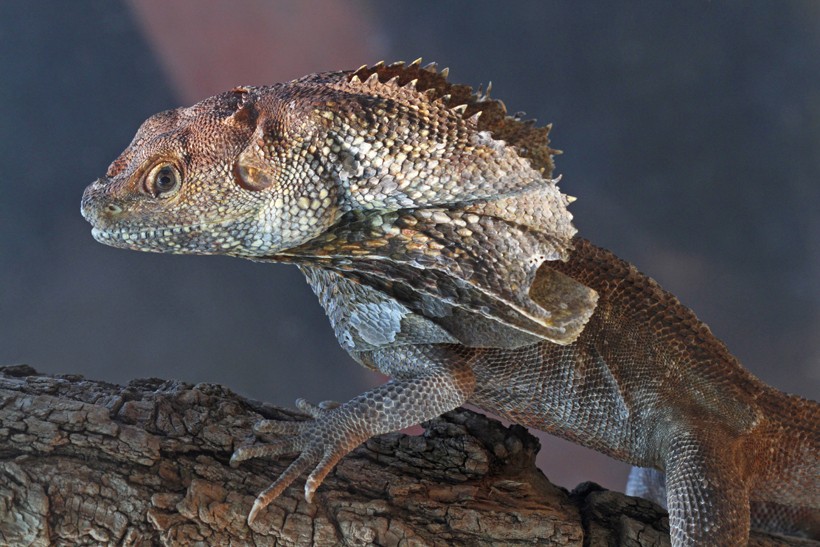
Frilled lizards are highly vulnerable on open ground, therefore they always have a tree near
?
Image credits: Kevin M. McCarthy/Shutterstock
The frilled lizard spends most of the day on the bark of a tree, scanning the ground for any potential prey. Once a prey item is spotted, the lizard crawls down and sprints on its hind legs to catch it before it gets away.
Without venom or strength required to bring down larger prey, its diet consists mainly of small insects, spiders and small lizards.
On the forest grounds, the frilled-neck lizard is quite vulnerable to its predators. It is completely defenceless against its predators like dingoes and large snakes. However, raptors like eagles, owls and kites are the most formidable of all frilled-neck lizard predators. Especially due to their sharp eyesight and strong claws, these birds have less difficulty in spotting and hunting a frilled lizard.
As a safety measure, the lizard stays away from open grounds and is often found camouflaged in trees.
The frilled-neck lizard is always close enough to a tree, even when it hunts on the ground. At the slightest sense of danger, the lizard quickly sprints back to the tree to hide and wait till the threat passes by. It sticks to the bark of a tree and lies there motionless to stay undetected by its predator. The brown and black colour of its skin perfectly match to the dry tree bark of the woodlands.
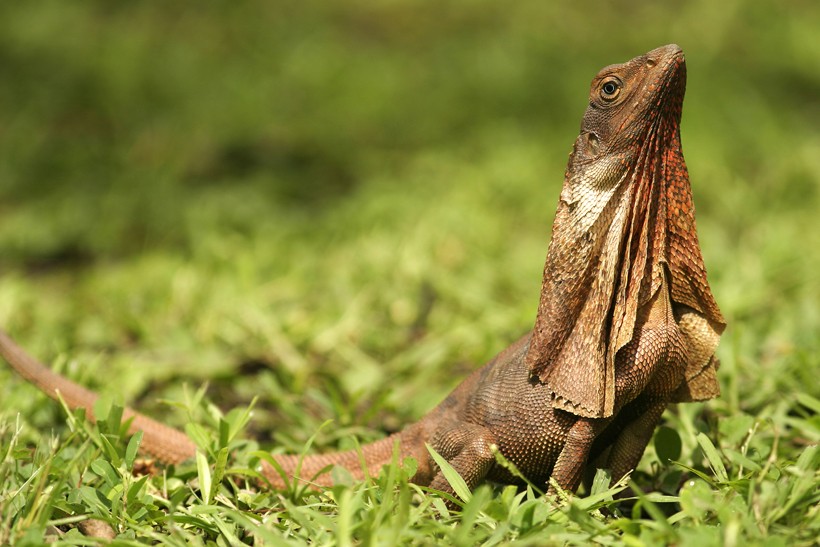
Frilled lizards heat themselves by incorporating heat from the environment
?
Image credits: Bildagentur Zoonar GmbH/Shutterstock
Australia and New Guinea are known for its wide range of reptile and arachnid species. Most of these species feed on small insects.
Inevitably, the frilled-neck lizard experiences constant competition for food and has to defend its territory from other species that hunt its prey items. It uses its frill and strength to push off rival males in its territory.
They aggressively defend territory and do not tolerate other males in the same area. Fights between males are not dangerous, as they match strengths by pushing each other like a human wrestling bout.
Their sharp teeth can inflict painful wounds but a frilled neck lizard bite is never fatal. At the end of the fight, the weaker one flees and the territory is won by the stronger lizard, leaving no one injured.
The frilled-necks carry out safe fights as they can’t risk being injured in territorial fights. Due to the unforgiving nature of its habitat, an injured lizard can easily fall prey or die out of hunger in a matter of days in the Australian woodlands.
Reproduction and life cycle
A frilled lizard reaches sexual maturity at a young age of just 18-20 months. Their mating system is classified as Polygynous, where an adult male mates with many females in one mating season.
They are capable of mating multiple times in a year. Frilled lizards mate between September to November, which is the early wet season in Australia and New Guinea.
During mating season, a frilled lizard has to compete with many rival males, in order to mate with as many as possible females.
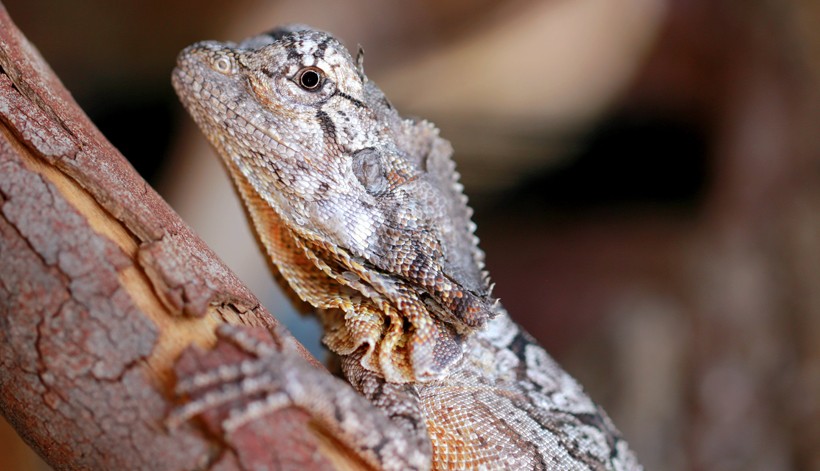
Frilled lizard young
?
Image credits: Nicole Sharp/Shutterstock
A female lays one to two clutches of eggs between November and February, with each clutch bearing up to 12-18 eggs. The number of eggs and clutches can vary depending on the condition of its habitat.
Frill-necks are cold-blooded animals and hence, the surrounding temperatures can also have an impact on the size and number of eggs, laid in a season. The female lays 3cm long eggs in a small burrow up to 2-3 feet underground and incubates them for 50-90 days.
The temperature inside the burrow has a significant impact on hatchlings; Males are born at higher temperatures and the cooler burrows bring more female hatchlings.
No parental care is observed but hatchlings stay together for 8-10 days despite being completely independent. They possess the abilities of hunting and using its frill as soon as they are born. But due to their small size and inexperience, the hatchlings are highly vulnerable to predation. Small birds and snakes frequently feed on baby frilled lizards. As a result, only a few of them reaches their adulthood.
Frilled lizard lifespan can be up to 15-20 years in a safe captive environment while their lifespan in the wild is yet to be known.
No hybrids of the Chlamydosaurus Kingii have been ever recorded in the wild or in captivity.
Behaviour & Communication
Frilled lizards are solitary hunters with a highly territorial behaviour. Due to their arboreal lifestyle, the frilled neck prefers to stay alone and quietly camouflaged in the woods. But when confronted by a male, it does not hesitate to get down. It aggressively defends its territory by fighting off rival males. On an average day, the frilled lizard simply sits on a tree, scanning the forest grounds for small insects and other prey.
Like all cold-blooded animals, the frilled lizard depends on its surroundings to maintain its inner body temperature at an appropriate level. They are more active during the day and can be seen basking in the cooler morning sun, every day for up 20-30 minutes. During a basking session, the lizard expands its frill; the 25cm wide frill increases its surface area facing the sun, thus helping the lizard absorb more heat in a less amount of time. Once done, the lizard quickly sprints back to the safety of a tree.
Due to their solitary behaviour, only minimal communication is observed between the individuals of this species. A frilled neck meets another frilled-neck only during territorial disputes and mating seasons.
They produce a hissing sound to warn rival males and open their mouths to display a gesture of aggression. The frill is also used by the frilled neck as a mode of communication in different circumstances. Against a threat, the frill is used to look larger and more intimidating than the opponent.
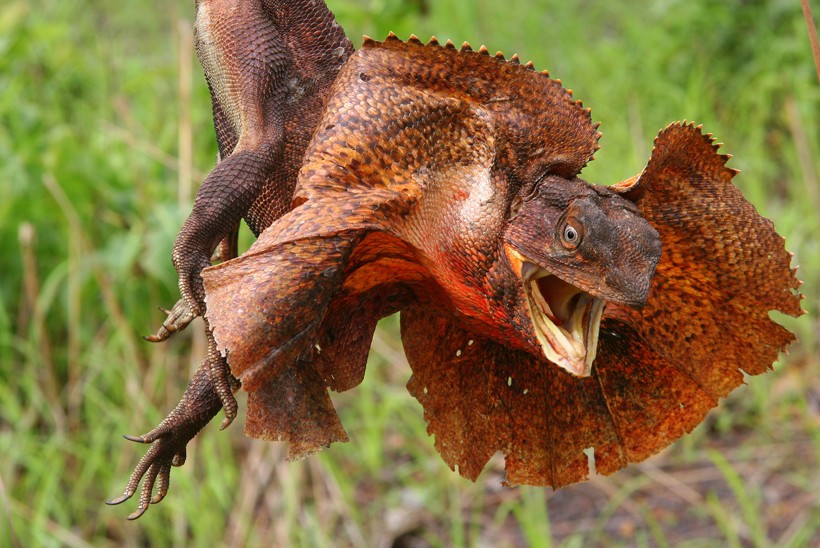
The frill helps the lizard in intimidating a rival, finding a mate and also in regulating body temperature.
?
Image credits: kkaplin/Shutterstock
While during mating season, the male frilled-necks display their bright patchy frills to attract females for mating. They also use a gesture called head-bobbing, where it nods its head up and down. This gesture is a very common mating ritual for reptiles and can also be used to warn a rival.
Based on its hunting skills, where it spots a prey from higher ground and then precisely chases it down on its hind legs at the ground level, it is speculated that the frilled lizard is a moderately intelligent species of reptiles. It also displays good wrestling skills while defending its territory against a rival male.
Evolution
Frilled lizards are classified as dragon lizards, a group that shares common characteristics like rough skin, wide heads, five toes and diurnal activity.
The lizards of the Agamidae family also share another very unique and impressive feature. Unlike other animals, their teeth are not formed on a socket in the bone but are actually fused to their jaw bones. Therefore, their teeth don’t fall off; they are stronger and more firm than other creatures.
Their closest relatives are the chameleons and iguanids, who also share the same jaw and teeth characteristics. There is very little known information about the exact ancestor of frilled-neck lizards. Frilled-neck characteristics like the frill and hind leg running style have been observed by many reptiles since the Jurassic period. Their order Squamata is speculated to have diversified in the Jurassic era. Since then many changes occurred and species differentiated from others over time. Iguanas and chameleons are more closely related to each other than they are to agamids. This piece of evidence is used to speculate that the family of Agamids evolved pretty much earlier than other squamates.
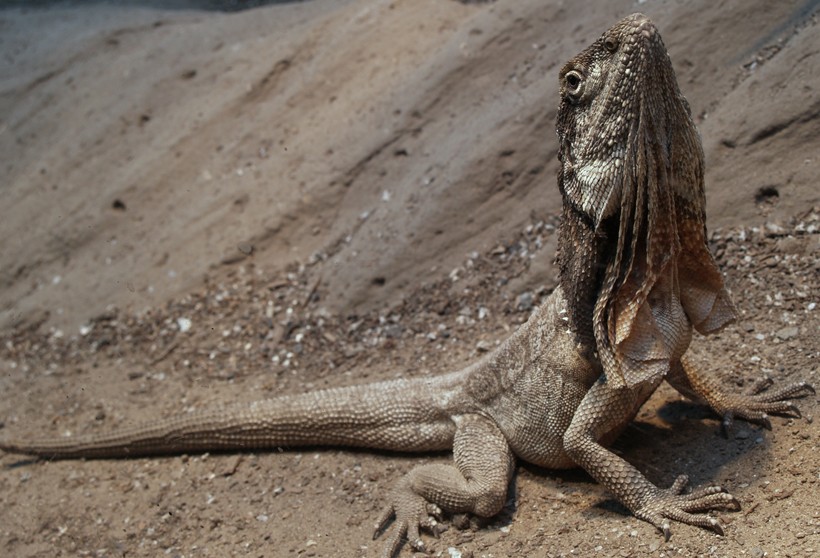
The frill and hind leg running style have been observed with many reptiles since the Jurassic period
?
Image credits: Tomas Pavelka/Shutterstock
Reptiles have been studied since the ancient times, due to their unique characteristics. However, very less information is extracted about their ancestors and their lifestyles.
Population and conservation status
The frilled lizards are usually found only in the woodlands in Northern Australia and New Guinea though sources of food can occasionally drive them to the lower desert regions of Australia.
The frilled lizard is on a never-ending battle against habitat loss, predation and the pet trade. Dry woods are chopped down at a large rate, resulting in drastic habitat loss for the frilled-necks. They lack defensive weapons in their arsenal, makes them an easy meal for predators, once the lizard’s camouflage is broken.
Due to their unique frill and running style, they are highly popular as exotic pets in many countries around the world.
Many lizards end up in captivity while many are raised inappropriately by amateur owners. However, as they feed on small insects, food sources are widely available for them and their population is found to be stable. The species is not under any conservation methods as they are not under any threat of extinction currently.
Funfacts
- Frilled neck lizards in Queensland have a bright yellow frill with black markings on it; while the ones found in Northern Australia and New Guinea have red and orange frills.
- They are one of the fastest running reptiles on hind legs and can achieve speeds of 25km/h.
- Their scaly skin helps them to reduce the loss of water in dry conditions.
- Their teeth are literally fused to their jaws.
- They depend on the sun to increase their body temperature. They are more active and fast at warmer body temperatures
- The frill is very important for a frilled lizard. It helps the lizard in intimidating a rival, finding a mate and also in regulating body temperature.
- The fictitious frilled Dilophosaurus, shown in the award-winning film Jurassic Park is more closely related to the frilled lizard than the actual Dilophosaurus.
- Due to its aggressive display of frills, they are often misunderstood as dangerous creatures.
- The lizard is considered and asset in Australia. The Australian 2-cent coins had the frilled-neck on it till 1991.
- The NORFORCE, which is an Australian Regional Force Surveillance Unit, uses frill-neck lizard on its emblem with a caption, “Ever Vigilant”, embedded on it.
